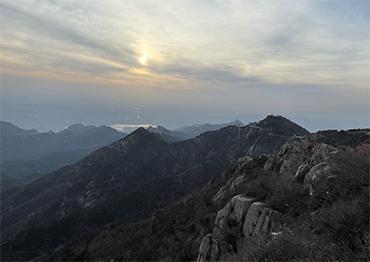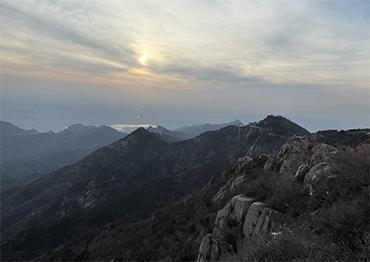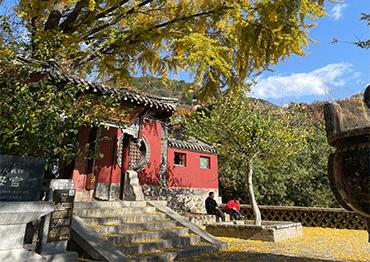If you’ve ever been curious about the scenes shown on China’s banknotes and their whereabouts, you may have pondered the landscape imprinted on the five-yuan bill. It portrays China’s most famous holy mountain – Mount Tai. The banknote shows the mountain’s peak, the 500-year-old “Welcoming-guest Pine” and a tablet intoning that this is “The Most Revered of the Five Sacred Mountains.”
Naturally, traveling to the mountain to take a picture holding the banknote at that specific spot is a popular activity. However, there’s much more to discover about this iconic mountain’s cultural and aesthetic significance than the five-yuan bill.
Mount Tai is beside Tai’an, a small city in East China’s Shandong Province. As you approach the city, you can’t miss the mountain. Its imposing peaks rise abruptly from the plains, reaching an elevation of 1,545 meters. It has long had an important place in Chinese culture, not only because of its natural beauty, but as a religious site and location for royal ceremonies. Over 85 emperors visited Mount Tai, starting in the ancient Shang Dynasty over 3,000 years ago. Eleven emperors – including the very first, Qin Shi Huang, who reigned from 221-210 BCE – carried out the most spectacular ceremonies there to worship heaven and earth and ensure their dynasty’s fortunes. Following the emperors, aristocrats, scholars and poets all climbed the mountain to experience its beauty and gain inspiration, leaving behind more than footprints – the area boasts 2,000 stone inscriptions.
The mountain’s summit is known as the Jade Emperor Peak and has a Daoist complex to worship its namesake in Chinese myth and folk religion. As Mount Tai is also associated with both Daoism and Buddhism, its slopes are home to 29 temples and shrines.
Many trek through the night to watch the sunrise. If you would like to do this, you should start at around midnight to reach the top at around 5 am. Standing on the raised East Pavilion, surrounded by gigantic, odd-shaped rocks and thick fog, you will see the sky gradually changing from gray to yellow to orange, until the sun jumps out of the ocean of clouds.
Of course, if you don’t want to endure an arduous night’s work, or if you would simply prefer to see the views on your ascent, you can watch the spectacular “golden belt of Yellow River” sunset instead from West Pavilion on the other side.
The best time to climb Mount Tai is from May to November. Although you might get sweaty during the climb, the temperature drops fast when you approach the summit, and the weather up there is unpredictable. One convenience on offer is that you can rent a thick coat at the top for a few dollars, rather than lugging one up yourself.
There are four trails leading up to the summit, starting at the four entrances of Hongmen, Tianwaicun, Taohuayu and Tianzhufeng. Among them, Hongmen is the most popular as its route has well-built stone steps all the way up, and many cultural points of interest. On the Hongmen route, a total of 6,660 steep stone steps wind their way up to the South Heaven Gate, offering views of lush forest, stark cliffs and rushing streams. The climb is not too challenging if you go slowly and take plenty of breaks. It should take about six hours, perhaps less if you are particularly fit.
The toughest section is a tight staircase, the Shibapan or Eighteen Mountain Bend, in which one ascends 400 meters up 1,827 narrow stone steps. Cliffs emblazed with inscriptions rise on both sides, which makes it appear like a stairway to heaven, echoing the mountain’s ancient title as “a heaven that leads to the throne.” It takes about an hour for an average climber to finish.
Feel free to travel light, as the mountain is quite commercialized. You will never be too far away from your next vendor selling walking sticks, T-shirts, bags, bottled water and all kinds of snacks like raw cucumbers, freshly made Shandong-style scallion wraps, ice cream and even dumplings. Indeed, at the top of the mountain, a whole food street awaits you with milk tea shops, multiple restaurants, fried chicken steak and burger stands, souvenir shops and even hotels for those who want to go straight back to bed after enjoying the sunrise.
Besides sightseeing and working up a good sweat, people come from afar to worship. You will see people praying to different gods for fortune, good health, marriage and fertility, making offerings such as fruits and nuts. Other than the Jade Emperor Peak, significant temples include Daimiao Temple, which means the God of Mount Tai at the foot of the mountain, which is now used as the museum of Tai’an City. It is the largest and most complete ancient building complex in the area. And Bixia Temple, which is dedicated to the Daoist goddess Bixia, or Blue Dawn.
If you are familiar with Mount Tai, you may have also seen clips on social media of exhausted hikers, legs wobbling like baby deer as they struggle down the mountain after the arduous climb up steps they are not used to. The easiest way to avoid this fate is to avoid walking down the mountain. From the peak, you can get one of two scenic cable cars down to one of the mountainside coach stations, where you can catch a ride to an exit. From there, you can hail a cab into town.
You will likely want to spend at least one night in Tai’an, and it is worth rewarding yourself with some local specialties after the day’s hiking. Local specialties include crispy Tai’an pancakes, which have a slightly sour flavor from fermented grain, a fresh “three beauties” soup made with high-quality cabbage, tender tofu and sweet spring water, and fried chicken marinated in rich, salty sauce with green chili, crispy ginger and garlic.

 Old Version
Old Version

